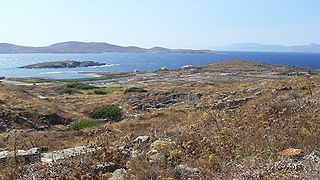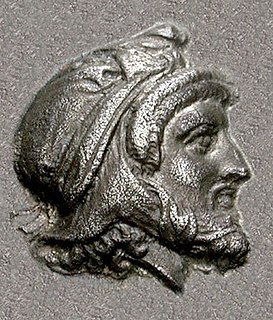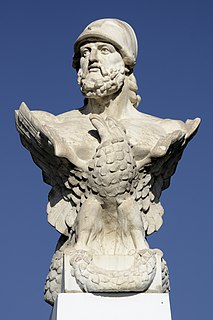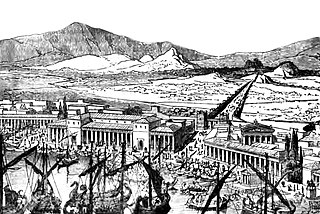Hellenotamiai (Attic Greek: ἑλληνοταμίαι [1] ) was an ancient Greek term indicating a group of public treasurers. [2] The Hellenotamiae were ten magistrates appointed by the Athenians (one from each tribe, possibly by election) to receive the contributions of the allied states, and were the chief financial officers of the Delian League. [3]

Attic Greek is the Greek dialect of the ancient city-state of Athens. Of the ancient dialects, it is the most similar to later Greek and is the standard form of the language that is studied in ancient Greek language courses. Attic Greek is sometimes included in the Ionic dialect. Together, Attic and Ionic are the primary influences on Modern Greek.

Ancient Greece was a civilization belonging to a period of Greek history from the Greek Dark Ages of the 12th–9th centuries BC to the end of antiquity. Immediately following this period was the beginning of the Early Middle Ages and the Byzantine era. Roughly three centuries after the Late Bronze Age collapse of Mycenaean Greece, Greek urban poleis began to form in the 8th century BC, ushering in the Archaic period and colonization of the Mediterranean Basin. This was followed by the period of Classical Greece, an era that began with the Greco-Persian Wars, lasting from the 5th to 4th centuries BC. Due to the conquests by Alexander the Great of Macedon, Hellenistic civilization flourished from Central Asia to the western end of the Mediterranean Sea. The Hellenistic period came to an end with the conquests and annexations of the eastern Mediterranean world by the Roman Republic, which established the Roman province of Macedonia in Roman Greece, and later the province of Achaea during the Roman Empire.

A treasurer is the person responsible for running the treasury of an organization. The significant core functions of a corporate treasurer include cash and liquidity management, risk management, and corporate finance.
They were first appointed in 477 BC, when Athens, in consequence of the conduct of the Spartan general Pausanias, had obtained the command of the allied states. The money paid by the different states, which was originally fixed at 460 talents, was deposited in Delos, which was the place of meeting for the discussion of all common interests; and there can be no doubt that the Hellenotamiai not only received, but were also the guardians of these monies, which were called by Xenophon Hellenotamia (Ἑλληνοταμία). [4] [5] [6] [7]

The city of Athens during the classical period of Ancient Greece was the major urban center of the notable polis (city-state) of the same name, located in Attica, Greece, leading the Delian League in the Peloponnesian War against Sparta and the Peloponnesian League. Athenian democracy was established in 508 BC under Cleisthenes following the tyranny of Isagoras. This system remained remarkably stable, and with a few brief interruptions remained in place for 180 years, until 322 BC. The peak of Athenian hegemony was achieved in the 440s to 430s BC, known as the Age of Pericles.

Sparta was a prominent city-state in ancient Greece. In antiquity the city-state was known as Lacedaemon, while the name Sparta referred to its main settlement on the banks of the Eurotas River in Laconia, in south-eastern Peloponnese. Around 650 BC, it rose to become the dominant military land-power in ancient Greece.

Pausanias was a Spartan regent, general, and war leader for the Greeks who was suspected of conspiring with the Persian king, Xerxes I, during the Greco-Persian Wars. What is known of his life is largely according to Thucydides' History of the Peloponnesian War, together with a handful of other classical sources.
The office was retained after the treasury was transferred from Delos to Athens in 454/453 BC, [3] on the proposal of the Samians. [6] [8] From 453 BC they paid the First Fruits to the treasury of Athena, and disbursed payments on the authority of the assembly, usually to Athenian general on campaign, but also for construction (e.g. Acropolis buildings). Some time around the oligarchic coup of 411 BC, a board of twenty Hellenotamiae were given authority over the state treasury of Athens, as well as that of the Delian League. [3]

A treasury is either

The island of Delos, near Mykonos, near the centre of the Cyclades archipelago, is one of the most important mythological, historical, and archaeological sites in Greece. The excavations in the island are among the most extensive in the Mediterranean; ongoing work takes place under the direction of the French School at Athens, and many of the artifacts found are on display at the Archaeological Museum of Delos and the National Archaeological Museum of Athens.

Athens is the capital and largest city of Greece. Athens dominates the Attica region and is one of the world's oldest cities, with its recorded history spanning over 3,400 years and its earliest human presence starting somewhere between the 11th and 7th millennium BC.
The office was abolished on the conquest of Athens by the Peloponnesians in 404 BC. The Hellenotamiae were not reappointed after the restoration of the democracy; for which reason the grammarians give us little information regarding their responsibilities and duties. The German classical scholar Philipp August Boeckh, however, concluded from inscriptions that they were probably ten in number, chosen by lot (like the treasurers of the gods) out of the Pentacosiomedimni , and that they did not enter upon their office at the beginning of the year, but after the Panathenaea and the first Prytaneia. With regard to their duties, Böckh supposes that they remained treasurers of the monies collected from the allies, and that payments for certain objects were assigned to them. In the first place they would of course pay the expenses of wars in the common cause, as the contributions were originally designed for that purpose; but as the Athenians in course of time considered the money as their own property, the Hellenotamiai had to pay the Theorica and military expenses not connected with wars on behalf of the common cause. [9] [10]
The Peloponnesian League was an alliance in the Peloponnesus from the 6th to the 4th centuries BC, dominated by Sparta. It is known mainly for being one of the two rivals in the Peloponnesian War, against the Delian League, which was dominated by Athens.
Theorica was in ancient Athens the name for the fund of monies expended on festivals, sacrifices, and public entertainments of various kinds; and also monies distributed among the people in the shape of largesses from the state.






